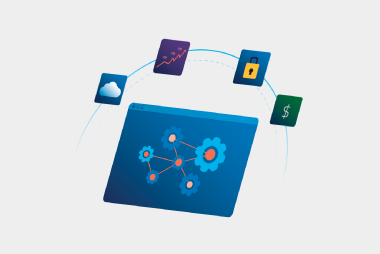For small and medium-sized suppliers, staying competitive means finding innovative ways to streamline operations while maximising profitability. One such solution is electronic data interchange (EDI). But before diving headfirst into this technology, it's essential for businesses to conduct a thorough cost-benefit analysis to determine if the investment aligns with their strategic goals.
Things to think about when putting together a cost-benefit analysis
Before you put your cost-benefit analysis together there are a few things to consider:
- Get your internal departments involved
Like all business projects, it’s important to keep the relevant departments who will be impacted by the change in the loop. This allows them to present any things that they want from the project and make sure all departments are happy. It also could impact what requirements you need in your EDI solution.
- Think about integration and web portal EDI solutions
For most small to medium businesses, you’ll normally have two choices to comply with EDI requirements. Integrated EDI solutions like our Gateway solution connect directly into your software. This allows you to use your own software to send and receive EDI messages. The other option is a web portal solution like Colladium.
Here's a breakdown of our two solutions:[vc_column_inner width="1/2" css=".vc_custom_1565317545162{padding-top: 0px !important;background-color: #00b7f1 !important;}"]
Consider EDI webforms if…
[vc_column_inner width="1/2" css=".vc_custom_1565315132956{padding-top: 0px !important;padding-bottom: 0px !important;background-color: #1b75bb !important;}"]
Consider an EDI gateway if…
[vc_column_inner width="1/2" css=".vc_custom_1565317604253{padding-top: 0px !important;background-color: #eeeeee !important;}"]
You trade with a small number of retailers
[vc_column_inner width="1/2" css=".vc_custom_1565317619229{padding-top: 0px !important;padding-bottom: 0px !important;background-color: #eeeeee !important;}"]
You trade with a large number of retailers
[vc_column_inner width="1/2" css=".vc_custom_1565317604253{padding-top: 0px !important;background-color: #eeeeee !important;}"]
You receive roughly 30 or less orders a week
[vc_column_inner width="1/2" css=".vc_custom_1565317619229{padding-top: 0px !important;padding-bottom: 0px !important;background-color: #eeeeee !important;}"]
You receive more than roughly 30 orders a week
[vc_column_inner width="1/2" css=".vc_custom_1565317604253{padding-top: 0px !important;background-color: #eeeeee !important;}"]
You sell a limited range of products
[vc_column_inner width="1/2" css=".vc_custom_1565317619229{padding-top: 0px !important;padding-bottom: 0px !important;background-color: #eeeeee !important;}"]
You sell a large range of products
[vc_column_inner width="1/2" css=".vc_custom_1565317604253{padding-top: 0px !important;background-color: #eeeeee !important;}"]
Your customers don’t require too much data
[vc_column_inner width="1/2" css=".vc_custom_1565317619229{padding-top: 0px !important;padding-bottom: 0px !important;background-color: #eeeeee !important;}"]
Your customers require a substantial amount of information
[vc_column_inner width="1/2" css=".vc_custom_1565317604253{padding-top: 0px !important;background-color: #eeeeee !important;}"]
Your software can’t generate the information required by your customers
[vc_column_inner width="1/2" css=".vc_custom_1565317619229{padding-top: 0px !important;padding-bottom: 0px !important;background-color: #eeeeee !important;}"]
You want automated processes
[vc_column_inner width="1/2" css=".vc_custom_1565317604253{padding-top: 0px !important;background-color: #eeeeee !important;}"]
You’re just starting out with EDI
[vc_column_inner width="1/2" css=".vc_custom_1565317619229{padding-top: 0px !important;padding-bottom: 0px !important;background-color: #eeeeee !important;}"]
You don’t want to double-enter data
[vc_column_inner width="1/2" css=".vc_custom_1565317604253{padding-top: 0px !important;background-color: #eeeeee !important;}"][vc_column_inner width="1/2" css=".vc_custom_1565317619229{padding-top: 0px !important;padding-bottom: 0px !important;background-color: #eeeeee !important;}"]
You need a flexible solution that grows as your business does
Looking at all factors for your cost-benefit analysis
Before you put your cost-benefit analysis together there are a few things to consider:
- Initial investment costs: Implementing an EDI integration solution can require upfront investment to set up. However, compared to traditional systems, the initial costs of EDI can often be recouped relatively quickly through the increased efficiency and reduced errors.
- Operational savings: One of the primary benefits of EDI is the significant reduction in manual data entry and processing time. This translates into staff being able to work on other priority tasks.
- Improved accuracy and compliance: Manual data entry is prone to errors, which can lead to costly mistakes. EDI integration can ensure data accuracy by automating the exchange of electronic documents between trading partners.
- Faster order processing and fulfillment: In today's on-demand economy, speed is paramount. EDI enables faster exchange of business documents, resulting in faster order processing and fulfillment cycles.
- Scalability and flexibility: EDI systems are designed to scale with business growth and adapt to evolving business needs. Whether it's adding new trading partners, integrating with existing ERP systems, or expanding into new markets, EDI provides the flexibility to support business expansion without significant disruptions.
- Competitive advantage: In today's hyper-competitive marketplace, staying ahead of the curve is essential for survival. Implementing EDI can provide small and medium-sized suppliers with a competitive edge by improving operational efficiency, reducing costs, and enhancing customer satisfaction. Moreover, many large retailers and corporations mandate EDI compliance, making it a prerequisite for doing business with them.
- Customer expectations and relationships: As consumer expectations continue to evolve, so do the demands placed on suppliers. EDI enables small and medium-sized suppliers to meet the increasing demands for speed, accuracy, and transparency in business transactions. By delivering a seamless and efficient ordering experience, suppliers can strengthen customer relationships and foster long-term loyalty.
Calculating savings
We’ve put together a useful tool to calculate the possible savings you would get from using an integrated EDI solutions, check it out here.
Need help putting together a business case for your EDI project, have a look at our whitepaper.Want to learn more about our implementation process? Ask our experts by getting in touch below.
Request a call
Chat with one of our experts
Just fill out your details below and we'll be in touch within one business day.

